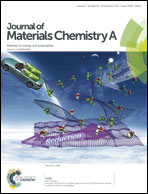Oxygen non-stoichiometry, conductivity and gas sensor response of SnO2 pellets
Abstract
SnO2 pellets lose a very small amount of oxygen at high temperatures to give, for instance, the stoichiometry SnO1.9989(1) at 1200 °C in air. The oxygen deficiency, δ can be preserved at ambient temperature in quenched samples. The level of conductivity, which is n-type, depends on oxygen content, 2-δ and varies by several orders of magnitude; activation energies cover the range 1.1 eV for slow-cooled, fully oxidised samples to 0.52 eV for samples quenched from 1200 °C. Quenched samples can be readily and reversibly reoxidised and reduced at temperatures as low as 700 °C; at lower temperatures, down to ∼350 °C, oxidation and reduction is mainly confined to sample surfaces on short timescales but, nevertheless, is sufficient for the conductivity to change by 1 to 2 orders of magnitude. Quenched, oxygen-deficient samples are also moisture-sensitive whereas fully oxidised samples are not. SnO2 shows similar sensitivity to both CO2 and N2, which is attributed to loss of O2 from the sample surface.


 Please wait while we load your content...
Please wait while we load your content...